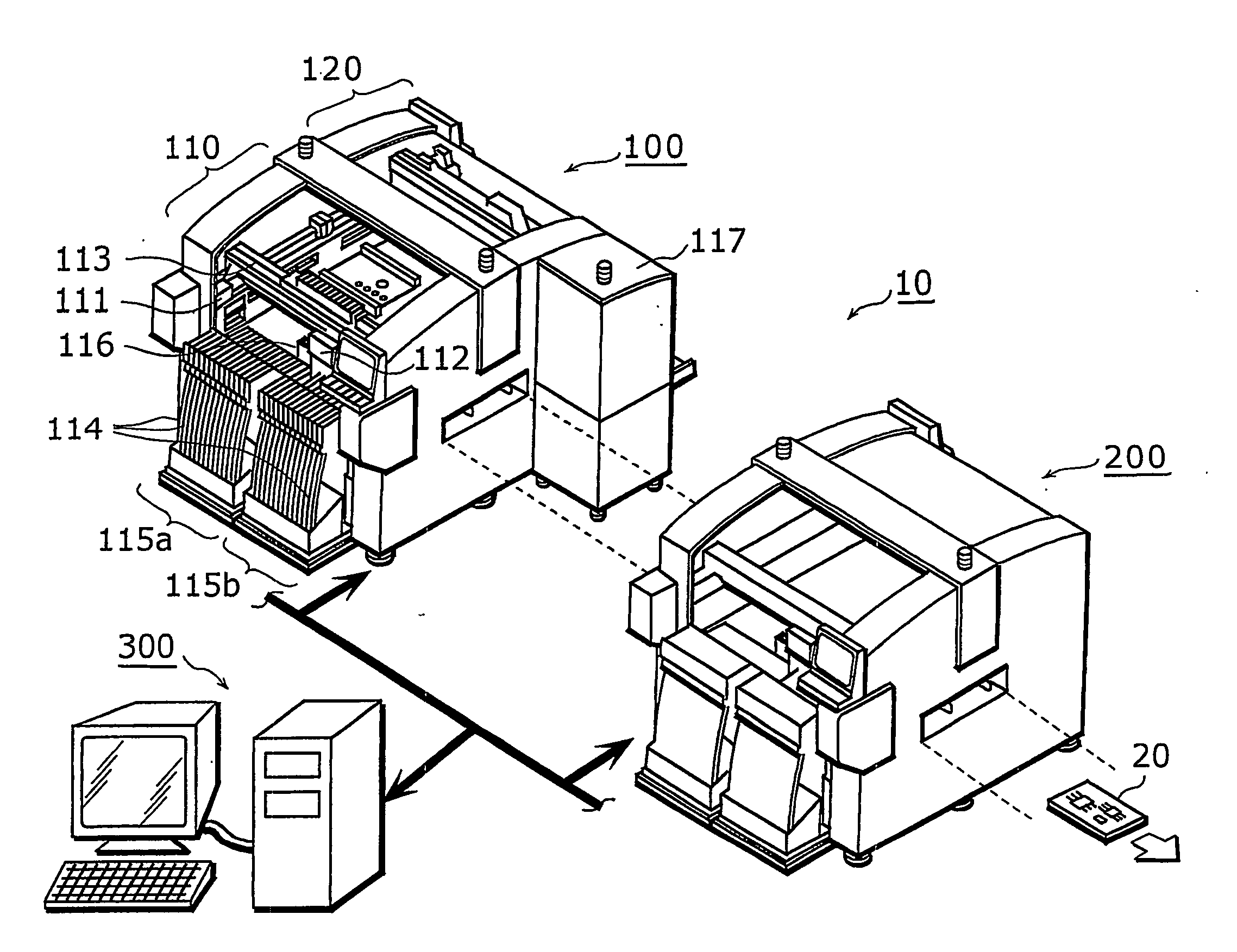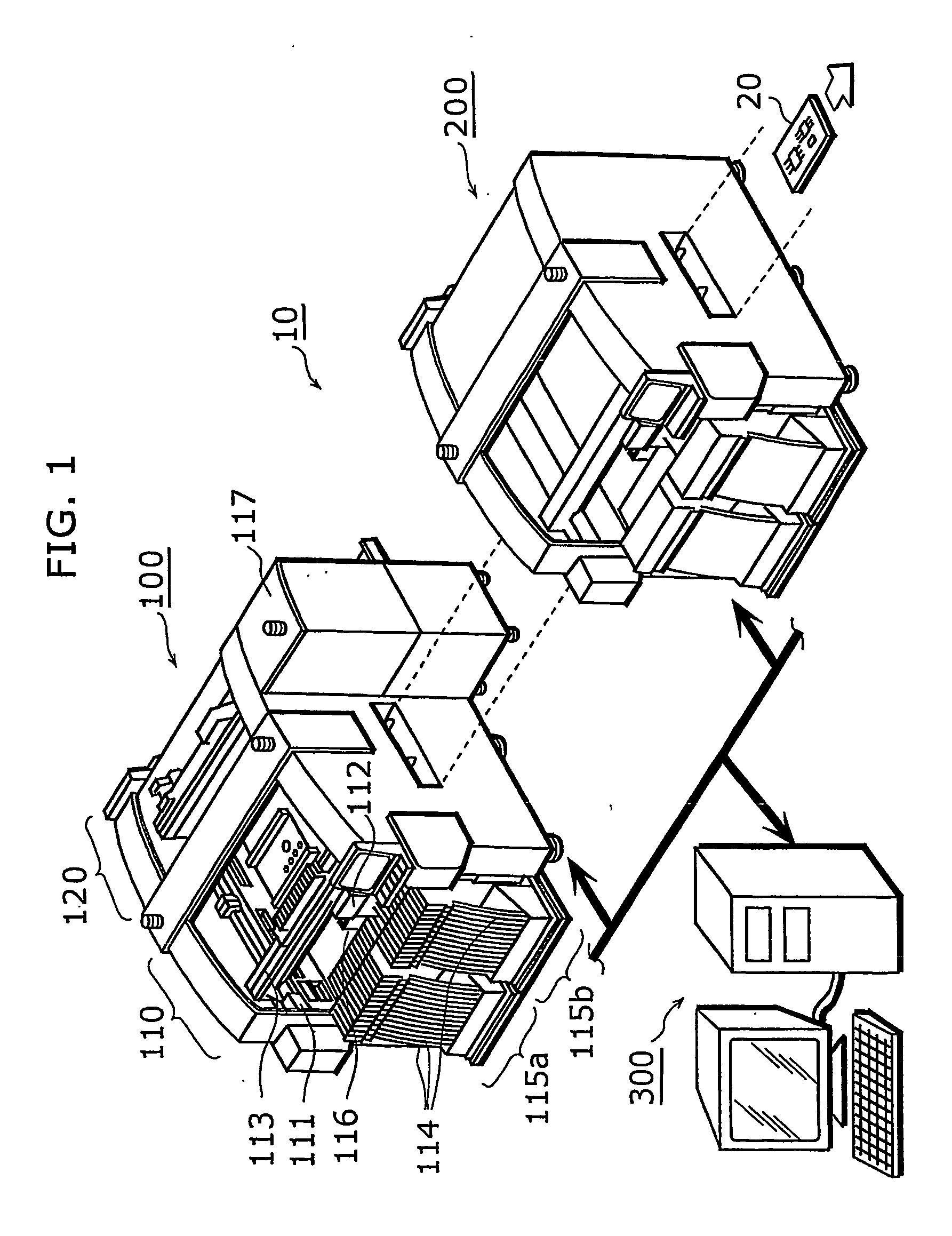Component verification method
a verification method and component technology, applied in the field of component verification methods, can solve the problems of missing components, unable to discover operating losses, and extra labor hours for generating component libraries, so as to save loading information labor, easy to read identification information, and fewer labor hours
- Summary
- Abstract
- Description
- Claims
- Application Information
AI Technical Summary
Benefits of technology
Problems solved by technology
Method used
Image
Examples
first embodiment
[0068] Referring to the drawings, the following describes the mounting system according to the first embodiment of the present invention.
[0069]
[0070]FIG. 1 shows the entire construction of a mounting system 10 according to the present invention. As shown in the drawing, the mounting system 10 is composed of a plurality (here, two) of mounters 100 and 200, and a component verification apparatus 300. The mounters 100 and 200 form a production line where electronic components are mounted onto a circuit board 20 that is transported downstream. The component verification apparatus 300 optimizes the mounting order of the required electronic components at the start of production, for example, based on information in a variety of databases, and sets and controls the mounters 100 and 200 having provided them with the NC data produced by the optimization.
[0071] The mounter 100 is equipped with two stages (a front stage 110 and a rear stage 120) that operate simultaneously and independently ...
second embodiment
[0190] Next, a description is given of a component mounting system according to the second embodiment of the present invention. The configuration of the component mounting system according to the present embodiment is the same as that presented in the first embodiment. However, the component mounting system according to the present embodiment is further capable of performing component arrangement data generation processing and component library generation processing to be described below, prior to component mounting.
[0191]
[0192]FIG. 23 is a flowchart showing component arrangement data generation processing.
[0193] Prior to component mounting, processing as shown in FIG. 23 is performed for generating component arrangement data. The component verification apparatus 300 checks the Z number of each of the components cassettes 114 that have been set, based on information from the respective switches 450 of the component supplying units 115a and 115b shown in FIG. 15 (S1A). Next, the co...
third embodiment
[0206] In the component mounting system 10 according to the first embodiment, the manufacturing information write processing (component management processing) is performed using data that is read from the IC tag attached to a reel, but in the component mounting system according to the third embodiment, manufacturing information write processing is performed using data that is read from the IC tag attached at the front of a component tape.
[0207] The following describes the component mounting system according to the present embodiment with reference to drawings.
[0208]FIG. 26 is a construction diagram showing the construction of the component mounting system according to the present embodiment.
[0209] This component mounting system is comprised of mounters 500 and 600 that mount electronic components 3 onto a printed board 2, as well as a control apparatus 700 that controls these mounters 500 and 600, thereby managing each of the electronic components 3 mounted on the printed board 2...
PUM
| Property | Measurement | Unit |
|---|---|---|
| radio frequency | aaaaa | aaaaa |
| widths | aaaaa | aaaaa |
| width | aaaaa | aaaaa |
Abstract
Description
Claims
Application Information
 Login to View More
Login to View More - R&D
- Intellectual Property
- Life Sciences
- Materials
- Tech Scout
- Unparalleled Data Quality
- Higher Quality Content
- 60% Fewer Hallucinations
Browse by: Latest US Patents, China's latest patents, Technical Efficacy Thesaurus, Application Domain, Technology Topic, Popular Technical Reports.
© 2025 PatSnap. All rights reserved.Legal|Privacy policy|Modern Slavery Act Transparency Statement|Sitemap|About US| Contact US: help@patsnap.com



